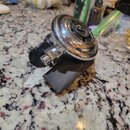I have polished a similarly “pitted” MK20 with the @rsingler recommended micromesh (few minutes spinning it around in there with a finger) and it came out perfectly smooth and works without leaks. I have also assembled a couple regs with the same level of wear without polishing and they too work just fine. Without polishing, even if it works fine, I suppose the oring may be prone to failing sooner running over a rougher surface but I have no long-term data/experience to confirm this.
You are using an out of date browser. It may not display this or other websites correctly.
You should upgrade or use an alternative browser.
You should upgrade or use an alternative browser.
Scubapro mk10 piston wall damage.
- Thread starter Tr4lover
- Start date
Please register or login
Welcome to ScubaBoard, the world's largest scuba diving community. Registration is not required to read the forums, but we encourage you to join. Joining has its benefits and enables you to participate in the discussions.
Benefits of registering include
- Ability to post and comment on topics and discussions.
- A Free photo gallery to share your dive photos with the world.
- You can make this box go away
I've got a mk-20 with a bit of crud on the wall. It seems to have some drift. Wondering if it is the cause. Need time to work on it...
I would put the piston edge under magnification and rule that out first, although I assume you’ve done that already.I've got a mk-20 with a bit of crud on the wall. It seems to have some drift. Wondering if it is the cause. Need time to work on it...
Still Kicking
Contributor
Pretty sure drift/creep is related to the HP seat and the piston edge. The wall damage would let air pass by the main piston o-ring and bubble out of the body. Easily evident.I've got a mk-20 with a bit of crud on the wall. It seems to have some drift. Wondering if it is the cause. Need time to work on it..
Drift isnt uncommon with SP pistons - not a huge deal if they lock up reliably.
Drift and creep are NOT the same thing....
Still Kicking
Contributor
I know.Drift and creep are NOT the same thing....
Tr4lover
Registered
Tr4lover
Registered
I just thought of a possible solution. I have a master cylinder boring tool that I use to restore a old Triumph tr4 master/slave cylinders. I'm thinking bores are about the same size as a mk10. This tool would allow me to cross hatch and clean up most of my mk10.
This being said I'm no expert on diving equipment. Cars are more in my wheel house. Would you see any benefits in using this tool?
This being said I'm no expert on diving equipment. Cars are more in my wheel house. Would you see any benefits in using this tool?
It may make you feel better about tossing it the scrap heap…I just thought of a possible solution. I have a master cylinder boring tool that I use to restore a old Triumph tr4 master/slave cylinders. I'm thinking bores are about the same size as a mk10. This tool would allow me to cross hatch and clean up most of my mk10.
This being said I'm no expert on diving equipment. Cars are more in my wheel house. Would you see any benefits in using this tool?
Sounds too aggressive, this is soft brass after all. You risk taking too much material off and then the piston head wont seal. Run it as is or use micromesh (very very fine sandpaper) with finger pressure.I just thought of a possible solution. I have a master cylinder boring tool that I use to restore a old Triumph tr4 master/slave cylinders. I'm thinking bores are about the same size as a mk10. This tool would allow me to cross hatch and clean up most of my mk10.
This being said I'm no expert on diving equipment. Cars are more in my wheel house. Would you see any benefits in using this tool?
Similar threads
- Replies
- 21
- Views
- 1,735
- Replies
- 9
- Views
- 911
- Replies
- 53
- Views
- 3,253




